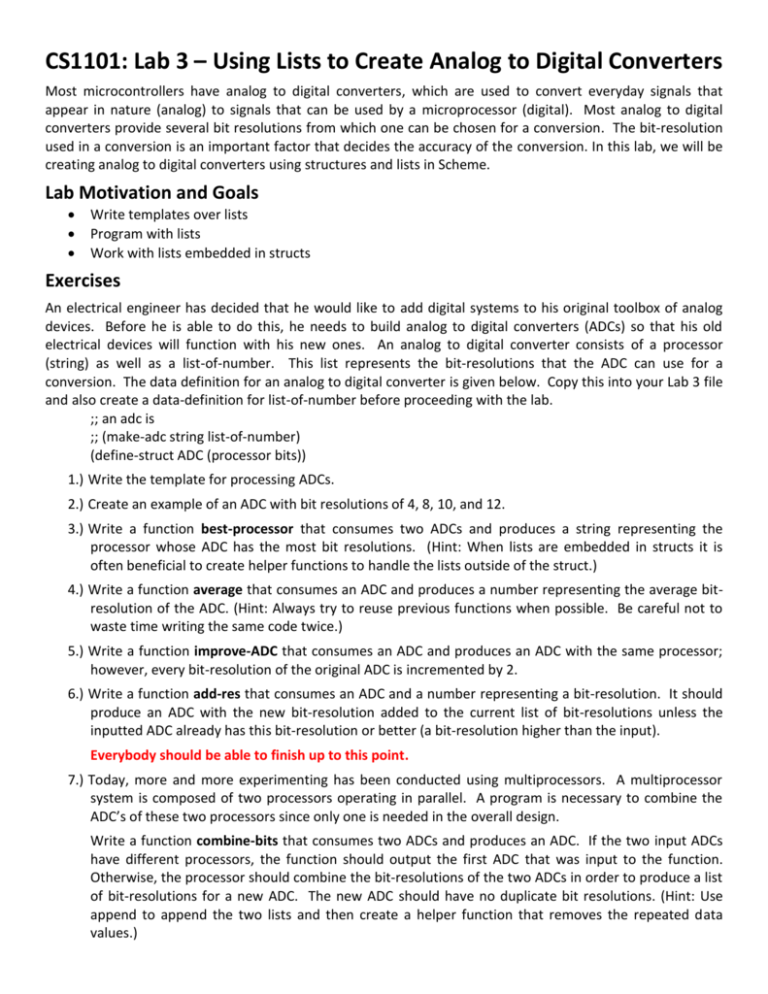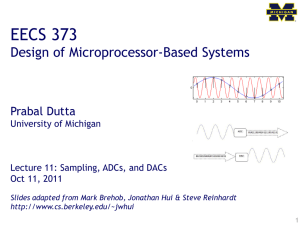CS1101: Lab 3
advertisement

CS1101: Lab 3 – Using Lists to Create Analog to Digital Converters Most microcontrollers have analog to digital converters, which are used to convert everyday signals that appear in nature (analog) to signals that can be used by a microprocessor (digital). Most analog to digital converters provide several bit resolutions from which one can be chosen for a conversion. The bit-resolution used in a conversion is an important factor that decides the accuracy of the conversion. In this lab, we will be creating analog to digital converters using structures and lists in Scheme. Lab Motivation and Goals Write templates over lists Program with lists Work with lists embedded in structs Exercises An electrical engineer has decided that he would like to add digital systems to his original toolbox of analog devices. Before he is able to do this, he needs to build analog to digital converters (ADCs) so that his old electrical devices will function with his new ones. An analog to digital converter consists of a processor (string) as well as a list-of-number. This list represents the bit-resolutions that the ADC can use for a conversion. The data definition for an analog to digital converter is given below. Copy this into your Lab 3 file and also create a data-definition for list-of-number before proceeding with the lab. ;; an adc is ;; (make-adc string list-of-number) (define-struct ADC (processor bits)) 1.) Write the template for processing ADCs. 2.) Create an example of an ADC with bit resolutions of 4, 8, 10, and 12. 3.) Write a function best-processor that consumes two ADCs and produces a string representing the processor whose ADC has the most bit resolutions. (Hint: When lists are embedded in structs it is often beneficial to create helper functions to handle the lists outside of the struct.) 4.) Write a function average that consumes an ADC and produces a number representing the average bitresolution of the ADC. (Hint: Always try to reuse previous functions when possible. Be careful not to waste time writing the same code twice.) 5.) Write a function improve-ADC that consumes an ADC and produces an ADC with the same processor; however, every bit-resolution of the original ADC is incremented by 2. 6.) Write a function add-res that consumes an ADC and a number representing a bit-resolution. It should produce an ADC with the new bit-resolution added to the current list of bit-resolutions unless the inputted ADC already has this bit-resolution or better (a bit-resolution higher than the input). Everybody should be able to finish up to this point. 7.) Today, more and more experimenting has been conducted using multiprocessors. A multiprocessor system is composed of two processors operating in parallel. A program is necessary to combine the ADC’s of these two processors since only one is needed in the overall design. Write a function combine-bits that consumes two ADCs and produces an ADC. If the two input ADCs have different processors, the function should output the first ADC that was input to the function. Otherwise, the processor should combine the bit-resolutions of the two ADCs in order to produce a list of bit-resolutions for a new ADC. The new ADC should have no duplicate bit resolutions. (Hint: Use append to append the two lists and then create a helper function that removes the repeated data values.) 8.) Write a function bit-levels that consumes an ADC and produces a list-of-number representing resolution levels the ADC is capable of producing. A resolution level is equal to 2 to the power of a bitresolution. (Note: It may be necessary for you to write your own power function. You can check the Scheme help first, but it would be good practice for you to write your own.) 9.) Write a function remove-odds that consumes an ADC and produces an ADC with all odd bit resolutions removed. (Note: We are doing this because it is very rare for a processor to use an odd-bit resolution for a conversion). (Hint: The modulo function of Scheme might help.) Wow you’re fast! These are a little more challenging, but are good extra practice. 10.) This problem will be completed in two-steps. We wish to create a function that will produce an ADC that is good for performing conversions with a set of accelerometers. All accelerometers will produce a .3 volt change on their output line when the sensor detects a change of 1g. Therefore, at 0g it outputs 0V, 1g outputs .3V, and so on. Some accelerometers have different output voltage ranges than others. This affects the conversion value received from that accelerometer. a.) Write a function ADC-Value that consumes a list-of-number representing bit-resolutions of an ADC and an accelerometer max output voltage (number) and produces a list-of-number representing the ADC conversion result for a 1g change on the accelerometer. This equation may help: 𝐴𝐷𝐶 𝑉𝑎𝑙𝑢𝑒 = .3∗2𝑛 𝐼𝑛𝑝𝑢𝑡 𝑉𝑜𝑙𝑡𝑎𝑔𝑒 𝑅𝑎𝑛𝑔𝑒 (where n = bit-resolution value). b.) Write a function remove-bad-res that consumes an ADC and an accelerometer max output voltage (number) and produces an ADC with all bit-resolutions that cannot be used in conversions with this accelerometer removed. (Hint: A bit-resolution is not appropriate when it produces a result less than 1 since this means the ADC is not accurate enough to display the necessary information.) 11.) This problem will also be completed in two-steps. We want to determine if all bit-resolutions of an ADC are capable of performing the conversion of a certain input signal with error less than a specified amount. a.) Write a function get-error that will consume a list-of-number representing the bit-resolutions of an ADC and a number representing the maximum value of an input signal to the ADC. This function should produce a list-of-number that represents the maximum error for each bit𝐼𝑛𝑝𝑢𝑡 𝑉𝑜𝑙𝑡𝑎𝑔𝑒 𝑅𝑎𝑛𝑔𝑒 resolution. This equation may help: 𝑀𝑎𝑥 𝐸𝑟𝑟𝑜𝑟 = . 2𝑛+1 b.) Write a function good-ADC? that consumes an ADC, a number representing the maximum value of the input signal, and a number representing the maximum error wanted. It produces true if all bit-resolutions produce a max error value less than the maximum error inputted to the system. It produces false otherwise. 12.) Write a function sort that consumes an ADC and produces an ADC such that all bit-resolutions in the new ADC are sorted from smallest to largest. (This function requires a different approach than the others. We will be covering it later in class, but give it a try and see what you come up with).





